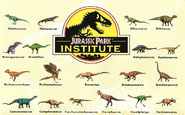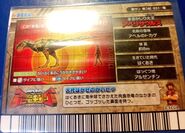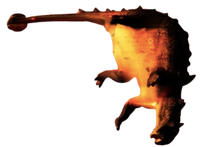
| Abelisaurus Temporal range: Late Cretaceous | |
|---|---|

| |
| Abelisaurus comahuensis as it appeared in Dinosaur King | |
| Scientific classification | |
| Kingdom: | Animalia |
| Phylum: | Chordata |
| Class: | Sauropsida |
| clade: | Dinosauria |
| Superorder: | Theropoda |
| Family: | Abelisauridae |
| Subfamily: | Carnotaurinae |
| Genus: | †Abelisaurus Bonaparte & Novas, 1985 |
| Species: | A. comahuensis |
| Binomial name | |
| Abelisaurus comahuensis Bonaparte & Novas, 1985 | |
| Type strain | |
| MC 11708 | |
The large theropod Abelisaurus comahuensis was similar to Albertosaurus from Alberta, Canada especially in it's size and lifestyle. It was a bipedal carnivore that probably reached 7 to 9 meters (25 to 30 feet) in length, although it is known from only one partial skull. But it's skull led two Argentinian paleontologists to put it in it's own family now known as the Abelisaurida. It lived in Argentina during the Late Cretaceous, 70 to 66 million years ago.
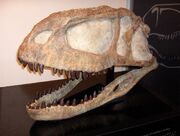
Abelisaurus Skull
Discovery and naming[]
Coining the type species Abelisaurus comahuensis, both genus and species were described by Argentine paleontologists José Bonaparte and Fernando Emilio Novas in 1985. The generic name recognizes Roberto Abel as the discoverer of the type specimen, and also as the former director of the provincial Museum of Cipolletti in Argentina. It also incorporates the Greek σαυρος ('sauros'), meaning 'lizard'. The specific name comahuensis is named after the Comahue region of Argentina, where the fossil was found.
The holotype, MC 11078, was uncovered at the "Cantera de la Pala Mécanica" site in the Lago Pellegrini quarries exploited by Abel since 1975. This single known fossil of Abelisaurus consists of a skull, lacking the lower jaws, especially on the right side. Most of the connections between the snout and the back of the skull are absent. It is also missing most of the palate. Despite the missing pieces, it could be estimated at over 85 centimetres.
Description[]
As only the skull is known, it has proven difficult to provide a reliable size estimation of Abelisaurus. It has confirmed that abelisaurids have relatively short heads. In 2010, Gregory S. Paul estimated its body length at ten metres (32 ft 10 in), its weight at 3 tonnes (3 long tons; 3 short tons). In 2012 Thomas Holtz gave a possible length of 11 metres (36.3 feet). In 2016, its length was estimated to be 7.4 metres (24 ft 3 in) in a comprehensive analysis of abelisaur size. Others authors gave a similar size at 7.2 metres (23.6 feet) and 1.65 tonnes (1.82 short tons).
Skull length was estimated at 85 centimetres (33 1⁄2 in) in 1985. The skull is relatively deep. Although there are no bony crests or horns, like those found in some other abelisaurids, such as Carnotaurus, rough ridges on the snout and above the eyes might have supported some kind of crest made out of keratin, which would not have become fossilized. The skull roof is thickened. There are also very large fenestrae (window-like openings) in the skull, which are found in many dinosaurs and reduce skull weight. One of these is a large triangular antorbital fenestra in the side of the snout. The eye socket behind it is rather high. It is constricted in the middle by bony projections of the lacrimal bone in the front and the postorbital bone at the rear. The eye was located above the constriction. Behind the eye socket a large triangular infratemporal fenestra is present. Its form reflects a strong forward inclination of the back of the skull. The front snout bone, the praemaxilla, bore four relatively small teeth. The maxilla behind it had at least seven, but perhaps as many as thirteen, larger teeth.
Classification[]
Abelisaurus in the newly created family Abelisauridae in 1985. They thought it was a member of the Carnosauria. Abelisaurus was the first abelisaurid named. Many other abelisaurids have since been discovered, including much more complete specimens of Aucasaurus, Carnotaurus and Majungasaurus. They showed that abelisaurids were not carnosaurs in the modern sense, but belonged to the Neoceratosauria instead. Some scientists place Abelisaurus as a basal abelisaurid, outside the subfamily Carnotaurinae. Others are less certain of its position. Abelisaurus shares some skull features, such as a relative elongation, with the carcharodontosaurids, a group unrelated to other species assigned to the Abelisauridae, and, since it is known only from a skull, it has been suggested that future discoveries may show that Abelisaurus was in fact a carcharodontosaurid. However, this is thought unlikely.
Paleobiology[]
It has been considered to be more closely related to theropod Ceratosaurus from the Jurassic Period. Only the skull of Abelisaurus been found, but its body proportions were probably similar to other large theropods with the same size skulls (three feet long). Carnotaurus had slender legs with the front shorter than the back. Since Carnotaurus probably was an early abelisaurid, scientists suppose that Abelisaurus also had short front limbs and slender legs. Other details of its body are unknown. The discovery of Abelisaurus is important because it shed light on many different southern-hemisphere theropods that are known only from fragmentary and puzzling material. These remains were difficutlt to identify and were occasionally used to suggest that late Cretaceous tyrannosaurids fromt the northern hemisphere were in the southern hemisphere. Now that good abelisaurid material has been discovered and described, sceintists have learned that many of those remains were abelisaurids. The possibility of southern-hemisphere tyrannosaurids is less likely.
In popular culture[]
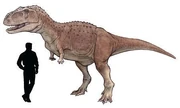
Abelisaurus size
Gallery[]
Abelisaurus/Gallery
References[]
- 1. Picture of Abelisaurus [1]
- 2. Main Information Credits to "ROMTECH" Computer CD Dinosaur Discovery


